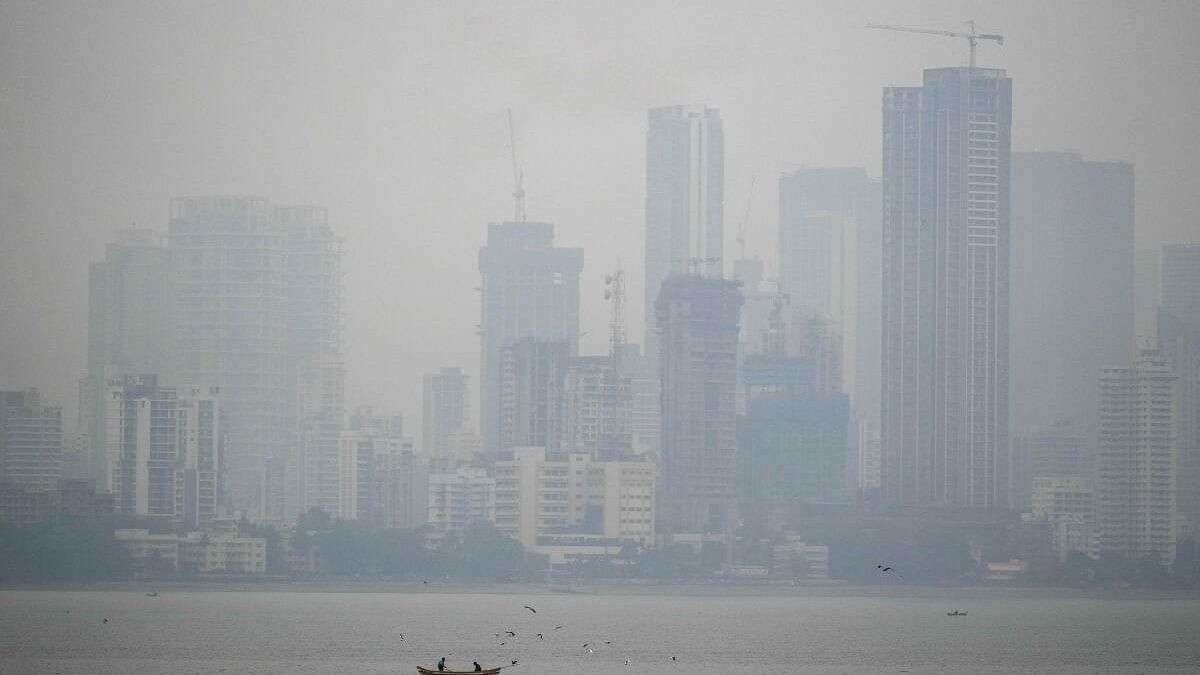
Fishermen row their boat as smog engulfs the city skyline, in Mumbai.
Credit: PTI Photo
As we sit writing this in our homes in New Delhi, our eyes burn and our throats itch, prompting us to check our weather app. It reports an Air Quality Index (AQI) of over 300. An AQI of 200 and above signifies ‘poor’ air quality, while 300 and above is considered ‘very poor’ air quality. Not far away, citizens in Mumbai have complained of similar issues in recent weeks: burning eyes, frequent headaches, and fatigue due to difficulty breathing. However, this wasn’t always the case.
Mumbai, situated on the Konkan coast, has historically reported better air quality compared to Delhi. The AQI bulletin released by the Central Pollution Control Board (CPCB) for November 8, 2017 indicated moderate air quality for Mumbai with an index value of 106. On the same day, Delhi recorded an AQI of 999, surpassing the upper limit of the worst category. This drastic difference in air quality, despite similar urbanisation and economic activities, can be attributed to local weather conditions, specifically wind patterns alternating from sea to land and land to sea during day and nighttime, respectively, acting as natural air purifiers for Mumbai.
However, in recent years, Mumbai’s air quality has competed with the notorious pollution levels of the New Delhi-NCR region. So, what changed?
Industrialization, vehicular emissions, and increased construction activities have always released harmful pollutants, but last year’s ongoing triple-dip La Nina event (2020–2023) disrupted normal weather patterns, according to the World Meteorological Organisation (WMO). La Nina is described as the cooler-than-normal phase of the ENSO phenomenon along the tropical west coast of South America. Its impact on the coastal wind speeds around Mumbai resulted in scarce and weak wind reversals from across the Arabian Sea, which would otherwise occur every two to three days and disperse pollutants in the air. This prevented the usual cleaning up of anthropogenic emissions, causing the air quality to drop.
This year, other factors have contributed too. Due to the delayed retreat of monsoons from the city, winds were comparatively calmer while the temperature increased to a four-year high in October, creating a thermal gradient between the city and the surrounding areas near the Sahyadri ranges. The higher pressure formed near the ranges causes the winds to blow towards the city from the higher altitudes, thus carrying dust particles with them, adding to the concentration of pollutants.
On the other hand, for the landlocked capital city, pollution during October–December has unfortunately become an annual event. With the start of October, the air quality drops to “poor,” with air quality index values averaging at 250+ in many parts. Human-driven causes like motor pollution, construction activities, burning of crop residue, and wood all contribute to this poor air quality. However, local conditions influence it too. October marks the end of monsoon season and is accompanied by a reversal of wind direction, from easterly to north-westerly. This north-westerly wind carries dust from Rajasthan and harmful gases like carbon monoxide, carbon dioxide, and smoke from Punjab. When the temperature falls, it lowers the inversion height, which is the layer in the atmosphere where the air temperature increases with height. This restricts the pollutants from the lower layer of the atmosphere from rising above the surface and spreading because warm air above cooler air does not let vertical mixing and trap pollutants, such as those at the surface level.
The harms of rising pollution levels are well known. There is a need to formulate data-driven and science-based policies and consequent actions, for example, a faster transition to electric vehicles, making renewable energy affordable and accessible to all, incorporating sustainable practices in the construction sector, and managing waste at all levels. The causes and impacts of air pollution are complex in nature and cut across boundaries; therefore, it needs cooperation and collaboration between inter-state authorities and a decentralised approach.
(Madhukar is asst professor, and Ananya Mohan is a masters’ student, TERI School of Advanced Studies, New Delhi.)